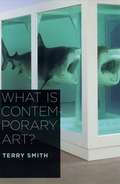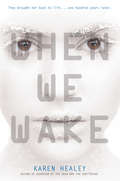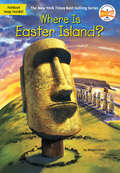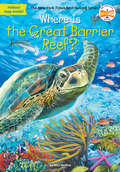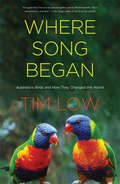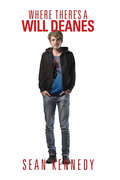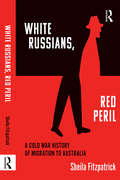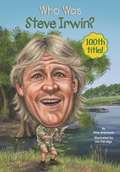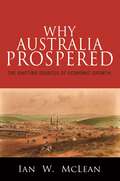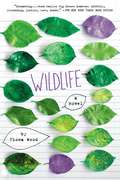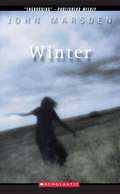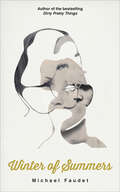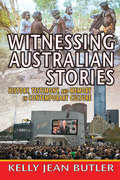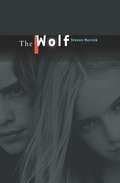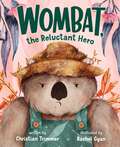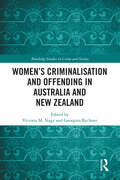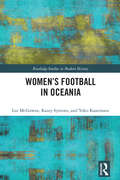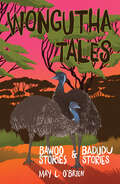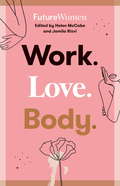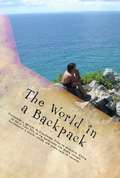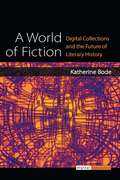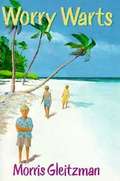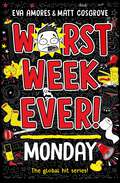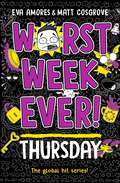- Table View
- List View
What Is Contemporary Art?
by Terry SmithWho gets to say what counts as contemporary art? Artists, critics, curators, gallerists, auctioneers, collectors, or the public? Revealing how all these groups have shaped today's multifaceted definition, Terry Smith brilliantly shows that a historical approach offers the best answer to the question: What Is Contemporary Art?
When We Wake (When We Wake Ser.)
by Karen HealeyMy name is Tegan Oglietti, and on the last day of my first lifetime, I was so, so happy.Sixteen-year-old Tegan is just like every other girl living in 2027--she's happiest when playing the guitar, she's falling in love for the first time, and she's joining her friends to protest the wrongs of the world: environmental collapse, social discrimination, and political injustice.But on what should have been the best day of Tegan's life, she dies--and wakes up a hundred years in the future, locked in a government facility with no idea what happened.Tegan is the first government guinea pig to be cryonically frozen and successfully revived, which makes her an instant celebrity--even though all she wants to do is try to rebuild some semblance of a normal life. But the future isn't all she hoped it would be, and when appalling secrets come to light, Tegan must make a choice: Does she keep her head down and survive, or fight for a better future?Award-winning author Karen Healey has created a haunting, cautionary tale of an inspiring protagonist living in a not-so-distant future that could easily be our own.
Where Is Easter Island?
by Megan Stine John HinderliterUnearth the secrets of the mysterious giant stone statues on this tiny remote Pacific island.Easter Island, in the middle of the Pacific Ocean thousands of miles from anywhere, has intrigued visitors since Europeans first arrived in the 1700s. How did people first come to live there? How did they build the enormous statues and why? How were they placed around the island without carts or even wheels? Scientists have learned many of the answers, although some things still remain a mystery. Megan Stine reveals it all in a gripping narrative.This book, part of the New York Times best-selling series, is enhanced by eighty illustrations.
Where Is the Great Barrier Reef (Where Is?)
by John Hinderliter Nico MedinaIn this Where Is? title, kids can explore the Great Barrier Reef--big enough to be seen from space but made up of billions of tiny living organisms.The Great Barrier Reef, off the coast of Australia, is the world's largest coral reef system. Stretching more than 1,400 miles, it provides a home to a wide diversity of creatures. Designated a World Heritage Site, the reef is suffering from the effects of climate change but this fascinating book shows this spectacular part of our planet. From the Trade Paperback edition.
Where Song Began: Australia's Birds and How They Changed the World
by Tim LowTim Low, award-winning author of Feral Future, in an eye-opening book on the unique nature of Australian birds and their role in ecology and global evolution. Renowned for its unusual mammals, Australia is a land of birds that are just as unusual, just as striking, a result of the continent''s tens of millions of years of isolation. Compared with birds elsewhere, ours are more likely to be intelligent, aggressive and loud, to live in complex societies, and are long-lived. They''re also ecologically more powerful, exerting more influences on forests than other birds. But unlike the mammals, the birds did not keep to Australia; they spread around the globe. Australia provided the world with its songbirds and parrots, the most intelligent of all bird groups. It was thought in Darwin''s time that species generated in the Southern Hemisphere could not succeed in the Northern, an idea that was proven wrong in respect of birds in the 1980s but not properly accepted by the world''s scientists until 2004 - because, says Tim Low, most ornithologists live in the Northern Hemisphere. As a result, few Australians are aware of the ramifications, something which prompted the writing of this book. Tim Low has a rare gift for illuminating complex ideas in highly readable prose, and making of the whole a dynamic story. Here he brilliantly explains how our birds came to be so extraordinary, including the large role played by the foods they consume (birds, too, are what they eat), and by our climate, soil, fire, and Australia''s legacy as a part of Gondwana. The story of its birds, it turns out, is inseparable from the story of Australia itself, and one that continues to unfold, so much having changed in the last decade about what we know of our ancient past. Where Song Began also shines a light on New Guinea as a biological region of Australia, as much a part of the continent as Tasmania. This is a work that goes far beyond the birds themselves to explore the relationships between Australia''s birds and its people, and the ways in which scientific prejudice have hindered our understanding. ''Tim Low is the rare author who is able to turn complex and sophisticated research into a form digestible to the general reader without ''''dumbing down'''' the science . . . A brilliantly readable book that not only gives Australian birds recognition long overdue, but allows for a fresh understanding of the way the world (and particularly our island continent) functions. '' Sean Dooley, Sydney Morning Herald''Low has written a book that is highly informative, but also most readable. Twitchers everywhere will rejoice, but there is also much here that ordinary readers will enjoy. Where Song Began teaches us all a huge amount about our birds--not least that we should be very proud of them. Thoroughly recommended. '' Lucy Sussex, Sunday Age''Stuffed with the fruits of long experience, wide travels (is there anywhere Tim Low hasn''t been?) and deep research. '' The Saturday Paper''Esteemed Australian biologist Tim Low tells the incredible story of the origins of global bird life . . . And this story is exciting: ambitious in scope and filled with daring reconstructions of the past, Low''s provocative study turns a number of evolutionary assumptions on their heads . . . Low''s book will sensitise readers to their bird-filled environments and inject critical insights into ecological pasts and futures. '' Lucy Van, Readings Monthly''If you have an interest in natural history and the environment, read this book and you won''t look at Australia in quite the same way again . . . Crammed with intriguing facts and ideas . . . A serious feat of synthesis that few bird observers or natural historians, let alone few authors, would have the knowledge, experience, time or access to academic resources to pull together. '' Bob Beale, Sunday Age''The story . . . will be a revelation for most readers . . . crammed with intriguing facts and ideas . . . with outbreaks of first-class storytelling . . . Where Song Began is a serious fea...
Where There's a Will Deanes (Get Out #4)
by Sean KennedyGet Out: Book FourMicah Johnson is coming back to Melbourne, and the story of him and his friends is coming to an end. Or will it be a new beginning? Will Deanes and Micah Johnson have a past, one that ranges from bitter enemies to best friends. There might be an undercurrent of something else, but Micah remains oblivious, and all Will can do is try to move on. Except now Micah’s returning to Melbourne full-time, and that means they can’t avoid each other or the tensions that arise. Will is still dealing with an injury that ended his football career, while Micah’s continues to thrive. As they face highs, lows, and family tragedies, they’ll have to get to know each other all over again. Will Micah see that Will means much more to him than a friend?
"White Russians, Red Peril": A Cold War History of Migration to Australia
by Sheila FitzpatrickOver 20,000 ethnic Russians migrated to Australia after World War II – yet we know very little about their experiences. Some came via China, others from refugee camps in Europe. Many preferred to keep a low profile in Australia, and some attempted to ‘pass’ as Polish, West Ukrainian or Yugoslavian. They had good reason to do so: to the Soviet Union, Australia’s resettling of Russians amounted to the theft of its citizens, and undercover agents were deployed to persuade them to repatriate. Australia regarded the newcomers with wary suspicion, even as it sought to build its population by opening its door to more immigrants. Making extensive use of newly discovered Russian-language archives and drawing on a lifetime’s study of Soviet history and politics, award-winning author Sheila Fitzpatrick examines the early years of a diverse and disunited Russian-Australian community and how Australian and Soviet intelligence agencies attempted to track and influence them. While anti-Communist ‘White’ Russians dreamed a war of liberation would overthrow the Soviet regime, a dissident minority admired its achievements and thought of returning home.
Who Was Steve Irwin? (Who was?)
by Dina Anastasio Jim EldridgeBy popular demand, the 100th Who Was...? subject is Steve Irwin!Steve Irwin did not have a typical childhood. Born in Melbourne, Australia, on February 22, 1962, he was raised on the wildlife park his parents owned. He cared for the animals and especially loved reptiles--he got a python for his sixth birthday! At nine years old, Steve was already helping his father wrestle small crocodiles. He became a crocodile trapper after graduating high school, catching the creatures before dangerous poachers could. Steve met his wife, Terri, at his family's park, and instead of a honeymoon, the pair filmed a wildlife documentary that led to the creation of the well-known series The Crocodile Hunter. Tragically, Steve was killed on September 4, 2006 while filming a documentary when a stingray attacked, piercing his heart. He was forty-four years old. However, his life's work obviously still strikes a chord with kids who voted him the winner of the 100th Who Was...? title.
Why Australia Prospered: The Shifting Sources of Economic Growth (The Princeton Economic History of the Western World #43)
by Ian W. McLeanThis book is the first comprehensive account of how Australia attained the world's highest living standards within a few decades of European settlement, and how the nation has sustained an enviable level of income to the present. Why Australia Prospered is a fascinating historical examination of how Australia cultivated and sustained economic growth and success. Beginning with the Aboriginal economy at the end of the eighteenth century, Ian McLean argues that Australia's remarkable prosperity across nearly two centuries was reached and maintained by several shifting factors. These included imperial policies, favorable demographic characteristics, natural resource abundance, institutional adaptability and innovation, and growth-enhancing policy responses to major economic shocks, such as war, depression, and resource discoveries. Natural resource abundance in Australia played a prominent role in some periods and faded during others, but overall, and contrary to the conventional view of economists, it was a blessing rather than a curse. McLean shows that Australia's location was not a hindrance when the international economy was centered in the North Atlantic, and became a positive influence following Asia's modernization. Participation in the world trading system, when it flourished, brought significant benefits, and during the interwar period when it did not, Australia's protection of domestic manufacturing did not significantly stall growth. McLean also considers how the country's notorious origins as a convict settlement positively influenced early productivity levels, and how British imperial policies enhanced prosperity during the colonial period. He looks at Australia's recent resource-based prosperity in historical perspective, and reveals striking elements of continuity that have underpinned the evolution of the country's economy since the nineteenth century.
Wildlife
by Fiona WoodDuring a semester in the wilderness, sixteen-year-old Sib expects the tough outdoor education program and the horrors of dorm life, but friendship drama and an unexpected romance with popular Ben Capaldi? That will take some navigating. New girl Lou has zero interest in fitting in, or joining in. Still reeling from a loss that occurred almost a year ago, she just wants to be left alone. But as she witnesses a betrayal unfolding around Sib and her best friend Holly, Lou can't help but be drawn back into the land of the living. Fans of Melina Marchetta, Rainbow Rowell, and E. Lockhart will adore this endearing and poignant story of first love, true friendship, and going a little bit wild.
Winter
by John MarsdenFor 12 years Winter has been haunted. And now, at 16, she must head back to her old home, where a pair of family tragedies forever altered her life. What she discovers is powerful and shocking but must be dealt with in order for life to go on.
Winter of Summers (Michael Faudet Ser. #4)
by Michael FaudetMichael Faudet&’s latest book explores the fine line between love and loss, the fragility of relationships, self-empowerment, and social commentary. Every page taking the reader to a world of conflicting emotions, where nothing is what it seems and beautiful dreams come to life. All exquisitely captured in a thought-provoking collection of poetry, prose, and short stories.
Witnessing Australian Stories: History, Testimony, and Memory in Contemporary Culture (Memory And Narrative Ser.)
by Kelly Jean ButlerThis book is about how Australians have responded to stories about suffering and injustice in Australia, presented in a range of public media, including literature, history, films, and television. Those who have responded are both ordinary and prominent Australians—politicians, writers, and scholars. All have sought to come to terms with Australia's history by responding empathetically to stories of its marginalized citizens.Drawing upon international scholarship on collective memory, public history, testimony, and witnessing, this book represents a cultural history of contemporary Australia. It examines the forms of witnessing that dominated Australian public culture at the turn of the millennium. Since the late 1980s, witnessing has developed in Australia in response to the increasingly audible voices of indigenous peoples, migrants, and more recently, asylum seekers. As these voices became public, they posed a challenge not only to scholars and politicians, but also, most importantly, to ordinary citizens.When former Prime Minister Kevin Rudd delivered his historic apology to Australia's indigenous peoples in February 2008, he performed an act of collective witnessing that affirmed the testimony and experiences of Aboriginal Australians. The phenomenon of witnessing became crucial, not only to the recognition and reparation of past injustices, but to efforts to create a more cosmopolitan Australia in the present. This is a vital addition to Transaction's critically acclaimed Memory and Narrative series.
The Wolf
by Steven HerrickSixteen-year-old Lucy, living in the shadow of her violent father, experiences a night of tenderness, danger, and revelation as she and Jake, her fifteen-year-old neighbor, search for a legendary wolf in the Australian outback. Written in prose.
Wombat Said Come In
by Carmen Agra DeedyA kindhearted wombat offers refuge to a parade of animal friends during an Australian bushfire in a delightful new picture book from New York Times best-selling creators Carmen Agra Deedy and Brian Lies. Australian bushfires roar above Wombat&’s home. He is fortunate that his burrow is deep below ground and he is safe. He snuggles under his crazy quilt and drinks his tea. Then, one by one, five uniquely Australian animals – Wallaby, Kookaburra, Platypus, Koala, and Sugar Glider – seek refuge from the fires, and Wombat welcomes them all.When you have the heart of a wombat, there&’s always room for one more! Fellowship, empathy, and adorable Australian animals star in this delightfully heartwarming and funny story about help in the time of trouble from author Carmen Agra Deedy (14 Cows for America, The Library Dragon, The Rooster Who Would Not Stay Quiet) and Caldecott Honoree Brian Lies (The Rough Patch, Bats at the Beach). The book will delight children with Deedy&’s engaging story and Lies masterfully rendered animals. It is an ideal read-aloud for adults seeking a story with humor and heart. Generosity and kindness provide powerful SEL themes. Older readers will get a glimpse of the unique environmental challenges presented by the country&’s annual bushfire season.
Wombat, the Reluctant Hero
by Christian TrimmerA heartwarming and playful adventure that will inspire young readers to be a good neighbor and friend, based on the brave actions of the Australian wombat.Wombat liked her things just so. Everything had its place, and nothing was out of order.She couldn’t say the same about her neighbors. But that was their business, and Wombat didn’t concern herself with others’ business. When a very hot, dry summer causes dangerous fires in their neighborhood, a group of animals are desperate to find water and shelter. It will take the quiet heroism of a neighbor to provide resources and a cozy, cool, and safe burrow—a reluctant wombat who demonstrates the inspiring power of community. Wombat, the Reluctant Hero is inspired by the heroic and very real actions of the wombat, an animal that has helped other creatures survive droughts and wildfires in its native Australia. Author Christian Trimmer and illustrator Rachel Gyan celebrate this amazing mammal, who definitely has a thing or two to teach us about being a good neighbor.
Women’s Criminalisation and Offending in Australia and New Zealand (Routledge Studies in Crime and Society)
by Victoria M. Nagy Georgina RychnerWomen’s Criminalisation and Offending in Australia and New Zealand offers new research and analysis of women’s offending and criminalisation in Australia and New Zealand from British settlement through to the late twentieth/early twenty-first centuries. Drawing attention to women as offenders as understood in a multitude of ways, this collection highlights how women have been involved with crime and criminal behaviour, their treatment inside and outside of courts and prisons, and how women’s deviation from societal norms have attracted negative attention throughout the decades. For Aboriginal and Māori women especially, the responses were harsher than what they could be for non-indigenous women. The chapters cover a broad range of transgressions that women have been actively involved with, including theft, drug and alcohol abuse and offences, organised crime, and homicide, as well as how women’s behaviour and their bodies have been criminalised and responded to by authorities. What this collection demonstrates is that women have often chosen to be involved with crime and criminality, while on other occasions their behaviour, innocent as it was, was not considered acceptable by contemporaries, resulting in confusion and misapprehension of women who refused to fit a mould. Women’s Criminalisation and Offending in Australia and New Zealand brings together historical and criminological methods, theories, and scholars to shed light on how Australia and New Zealand’s colonial, later state, and national governments have sought to understand, control, and punish women. This collection will be of interest and value to scholars, students, and everyone with an interest in criminology, history, law, sociology, Indigenous studies, and Australian and New Zealand studies.
Women’s Football in Oceania (Routledge Studies in Modern History)
by Lee McGowan Kasey Symons Yoko KanemasuThis book presents the most comprehensive mapping and analysis of women’s football in Oceania and is the first to examine the game’s historical development alongside social, political and cultural issues, weaving origin stories with players’ day-to-day challenges. Alongside presentation of the contemporary state of play and its overarching narrative of women’s game in the region, the book highlights key issues, discusses established and emergent themes, examines relevant contexts, investigates the status of the game at local and national levels and lays foundations for further research. Its primary objective is to detail and illustrate the historical, social, and organisational development of the women’s game, including international tournaments, national competitions, and teams in an effort to amplify the efforts of the individuals that made or make a significant contribution to the game. It draws on extensive formal and informal discussion, realises insight, proposes the means and related fields of further investigation and generates new knowledge alongside the uncovering of old. Women’s Football in Oceania covers key events, actors and moments and fills a gap in research for scholars of sports history and women’s history.
Wongutha Tales
by May O'BrienFirst published as individual titles in 1992, May O' Brien' s stories were ground-breaking publications, presenting traditional Indigenous stories in a bilingual text and giving a unique insight into learning English as a second language from a First Nations perspective. Classic tales such as How Crows Became Black and Why the Emu Can' t Fly are still as fresh and appealing as ever for a new generation of junior readers. Plus May' s simple pronunciation guide for Wongutha words are perfect learning activities for the classroom.
Work. Love. Body.: Future Women
by Jamila Rizvi Helen McCabeIn 2020, the lives of Australian women changed irrevocably. With insight, intelligence and empathy, Jane Gilmore, Santilla Chingaipe and Emily J. Brooks explore this through the lenses of work, love and body, and ask: Will the Australia of tomorrow be more equal than the one we were born into? Or will women and girls remain left behind?While our country was shrouded in smoke in the early months of 2020, Australian women went about their daily business. They worked, studied, cleaned, did school runs, made meals. And they postponed looking after themselves because life got in the way.Then, in March, Australians were told to lock down. For all the talk of equality, it was primarily women who held the health of our communities in their hands as they took on the essential jobs to care, to nurse and to teach, despite an invisible danger. One year later, women across the country would march on behalf of those who were not safe in workplaces and their own homes.Never before has change been thrust so abruptly on modern Australian women - 2020 impacted our working lives, relationships and our health and wellbeing. And as a growing number of women agitate for change, it is time to demand what women want. So where do we go from here?One thing is very clear: the future is now, and it is female.
The world in a backpack: fun and hardship in Australia, South Africa, and the Fiji Islands.
by Claudiomar Matias Rolim FilhoIt was supposed to be just another exchange trip. He thought life would be easy, but experienced all the difficulties and hardship of an immigrant in a foreign country. He washed cars under the close inspection and shouts of the Slav mafia, watched blood squirt from his hands in a second-rate kitchen, carried couches in warehouses, washed dishes, walked kilometres with more than 10 kg of pamphlets on his back, made deliveries, unloaded truckloads of plasterboards with deranged brutes, panicked over utility bills and even jumped out of windows, Chavo del Ocho style, to avoid landladies... All in the space of six months. The mucking about, which outdid much of his small victories, is narrated with very personal, razor-sharp wit and the desperation of a 21-year-old man, alone, 13 hours from any known person, who resorted to words to forget the problems of a reality he was literally forced to live one day at a time. He was beaten, suffered, and into some trouble; he had fun, laughed and, above all, had an unforgettable life experience. Join him and put your world in a backpack!
A World of Fiction: Digital Collections and the Future of Literary History (Digital Humanities)
by Katherine BodeDuring the 19th century, throughout the Anglophone world, most fiction was first published in periodicals. In Australia, newspapers were not only the main source of periodical fiction, but the main source of fiction in general. Because of their importance as fiction publishers, and because they provided Australian readers with access to stories from around the world—from Britain, America and Australia, as well as Austria, Canada, France, Germany, New Zealand, Russia, South Africa, and beyond—Australian newspapers represent an important record of the transnational circulation and reception of fiction in this period. Investigating almost 10,000 works of fiction in the world’s largest collection of mass-digitized historical newspapers (the National Library of Australia’s Trove database), A World of Fiction reconceptualizes how fiction traveled globally, and was received and understood locally, in the 19th century. Katherine Bode’s innovative approach to the new digital collections that are transforming research in the humanities are a model of how digital tools can transform how we understand digital collections and interpret literatures in the past.
Worry Warts
by Morris GleitzmanWorried because his parents' constant fighting has been aggravated by their financial troubles, twelve-year-old Keith decides to solve the problem by running away to pick up a fortune in the Australian opal fields.
Worst Week Ever! Monday
by Matt Cosgrove Eva AmoresCould your worst week be funny too? Start Monday with a bang in the hilarious new series taking the world by storm. Justin Chase is having the WORST WEEK EVER! His Mum has just married a vampire. His Dad is driving a giant toilet on wheels. His cat has probably been abducted by aliens. A bully is making his first day at a new school miserable. And right now, he's hanging off the edge of a 10-metre-high diving tower in front of his entire class wearing nothing but rapidly disappearing crocheted swimmers! And it's only... MONDAY! The first book in the hilarious new seven-part highly-illustrated series for fans of the globally bestselling Treehouse series.
Worst Week Ever! Thursday (Worst Week Ever! #4)
by Eva Amores Matt CosgroveHave YOU ever had a bad week? The hilarious new series taking the world by storm. He&’s dressed up like a clown on national TV, his worst enemy is stealing the limelight, and there's definitely something weird happening with everyone's cats! Justin Chase is having the WORST WEEK EVER! At least he's found a new BFF in international pop sensation, teen heartthrob and Justin&’s name twin, Justin Chase, right? Maybe not... As a case of mistaken identity leads to a disastrous kidnapping and Justin forced to race against the clock (and the ferocious dog) to escape! Monday was mortifying, Tuesday was tumultuous, Wednesday was wild, but now it's... THURSDAY! The fourth book in the hilarious new seven-part highly-illustrated series for fans of Tom Gates, Diary of a Wimpy Kid and the Treehouse series.
